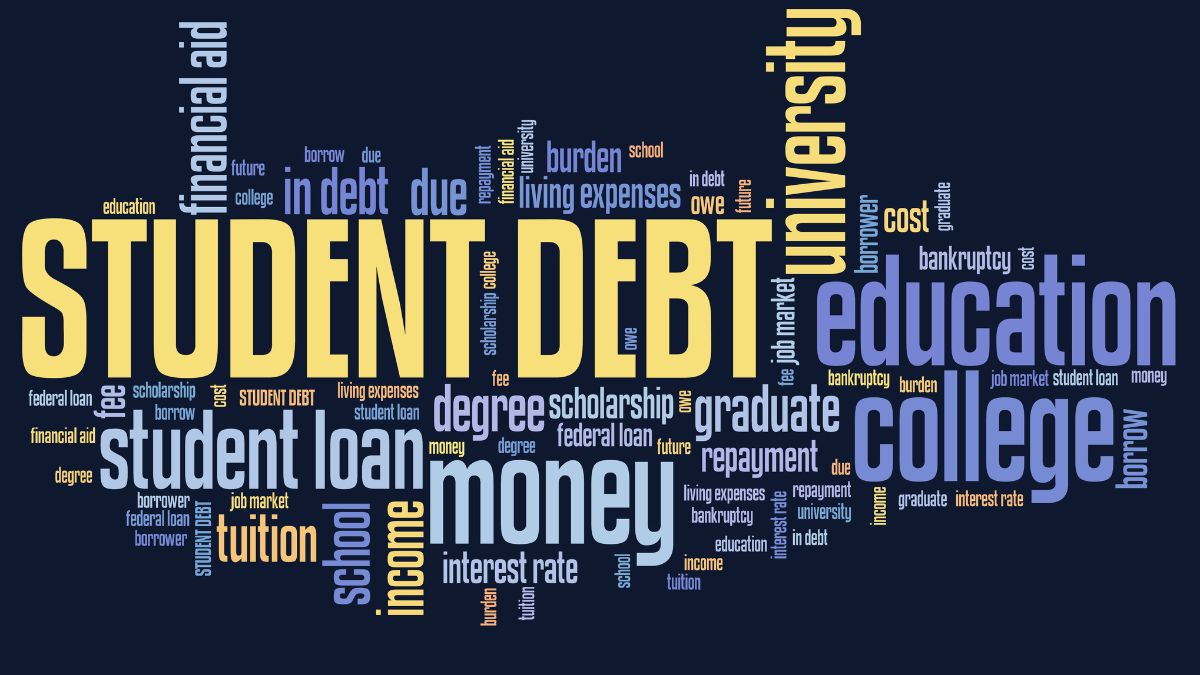Student debt is a topic that resonates deeply with millions of people across the world, particularly in the United States. For many, pursuing higher education is essential for securing a promising future. However, the escalating costs of tuition, housing, and other associated expenses have made student loans a financial necessity. Over time, this debt accumulates, leading to long-term financial struggles for graduates. This article explores the various dimensions of student debt, the challenges it presents, and possible solutions to mitigate its burden.

1. What is Student Debt?
Student debt refers to the money borrowed by students to pay for their education. These loans are often necessary to cover the costs of tuition, books, housing, and other associated expenses while attending college or university. The loans are typically provided by the government or private lenders, and they must be repaid with interest after graduation.
In the United States, student debt has reached a staggering $1.7 trillion, making it one of the largest forms of debt in the country, second only to mortgages. The heavy reliance on student loans has made it increasingly difficult for graduates to pay off their debts, impacting their financial health and life decisions.
2. Why Do Students Take on Debt?
The primary reason students take on debt is the rising cost of higher education. Over the past few decades, the cost of attending college has increased dramatically, far outpacing inflation and wage growth. Many families are unable to cover these costs out of pocket, leading students to borrow money to fund their education.
In addition to tuition, there are other costs that students must consider, such as textbooks, housing, transportation, and personal expenses. These added costs can push students to borrow more than they originally anticipated.
3. Types of Student Loans
There are two main types of student loans: federal and private.
- Federal Student Loans: These loans are provided by the government and typically come with lower interest rates and more flexible repayment options. They may also offer income-driven repayment plans and loan forgiveness programs.
- Private Student Loans: Private lenders, such as banks and credit unions, provide these loans. While private loans may offer larger borrowing amounts, they usually come with higher interest rates and less flexible repayment terms.
Most students start with federal loans due to their favorable terms, but some also take out private loans to cover any remaining costs that federal loans do not cover.

4. The Growing Problem of Student Debt
Student debt has become a major issue in the United States, with the average student loan borrower owing around $37,000 upon graduation. For students who pursue advanced degrees, such as law, medicine, or business, the debt load can be significantly higher, often exceeding $100,000.
This growing debt problem is compounded by the fact that many graduates struggle to find well-paying jobs immediately after leaving college. As a result, many are unable to make their loan payments on time, leading to increased interest, penalties, and a longer repayment period. This creates a cycle of debt that can take decades to pay off.
5. Impact on Graduates’ Financial Health
The burden of student debt affects graduates in multiple ways. First and foremost, it limits their ability to build wealth. Graduates with high student debt are often forced to delay major life milestones, such as buying a house, starting a family, or saving for retirement. The monthly loan payments can consume a significant portion of their income, leaving little room for other financial goals.
Moreover, student debt can have a lasting impact on an individual’s credit score. Missing loan payments or defaulting on a loan can damage credit, making it more difficult to secure mortgages, auto loans, or even rental agreements.
6. Emotional and Mental Stress of Student Debt
The financial strain of student debt can also take a toll on a person’s mental and emotional well-being. The constant pressure of making monthly payments, combined with the anxiety of having a large financial obligation, can lead to feelings of stress, hopelessness, and even depression.
Many graduates report that their student debt has caused them to feel overwhelmed and that it has limited their career choices. For example, some individuals may take jobs that pay less but offer loan forgiveness or avoid taking career risks because of their financial obligations.
7. Student Loan Repayment Plans
There are several repayment options available to help borrowers manage their student loans. The most common repayment plans include:
- Standard Repayment Plan: Fixed monthly payments over a period of 10 years.
- Graduated Repayment Plan: Payments start low and gradually increase every two years over a 10-year period.
- Income-Driven Repayment Plans: Payments are based on the borrower’s income and family size, with any remaining balance forgiven after 20 or 25 years of payments.
- Extended Repayment Plan: Allows borrowers to extend their repayment period beyond 10 years, which lowers the monthly payment amount but increases the total interest paid.
These options can help make student loan payments more manageable, but they also prolong the repayment process, which means borrowers will pay more in interest over time.

8. Loan Forgiveness Programs
For some borrowers, loan forgiveness programs offer a way to reduce or eliminate their student debt. Federal programs like Public Service Loan Forgiveness (PSLF) forgive the remaining balance on federal student loans after the borrower makes 120 qualifying payments while working for a government or nonprofit organization.
There are also forgiveness programs for specific professions, such as teachers and healthcare workers, that provide loan forgiveness after a certain number of years in service. However, navigating the requirements for these programs can be complex, and many borrowers have found it difficult to qualify for forgiveness.
9. The Debate Over Free College
The growing burden of student debt has sparked a national debate over whether college should be free. Proponents argue that free or low-cost education would provide greater access to higher education, reduce the need for student loans, and create a more educated workforce.
Critics of free college point out that it could be expensive to implement and may lead to unintended consequences, such as overcrowded universities or devalued degrees. Despite the debate, the idea of free college has gained traction in recent years, with some states and cities implementing tuition-free programs for community colleges and trade schools.
10. Potential Solutions to the Student Debt Crisis
There are several proposed solutions to the student debt crisis, each with its own pros and cons. These include:
- Income-Based Repayment Adjustments: Expanding income-driven repayment plans and making them more affordable for borrowers.
- Interest Rate Reductions: Lowering the interest rates on federal student loans to make them more affordable.
- Loan Forgiveness Expansion: Increasing the availability and scope of loan forgiveness programs to help more borrowers reduce their debt.
- Increased Grants and Scholarships: Providing more need-based grants and scholarships to reduce the reliance on student loans.
- Free or Low-Cost Education: Expanding tuition-free programs to more colleges and universities to reduce the need for borrowing.
Each of these solutions has the potential to alleviate the burden of student debt, but they would require significant policy changes and financial investment.
11. The Role of Financial Literacy
One often-overlooked aspect of the student debt crisis is the role of financial literacy. Many students take out loans without fully understanding the long-term implications of their decisions. Teaching students about budgeting, loan terms, interest rates, and repayment options could help them make more informed decisions about borrowing for their education.
Schools, universities, and policymakers could all play a role in improving financial education for students, ensuring that they are better equipped to manage their finances after graduation.
12. Is Student Debt Inevitable?
While student debt may seem inevitable for many, there are steps that students and their families can take to reduce the need for borrowing. These include:
- Attending Community College: Starting at a community college before transferring to a four-year institution can significantly reduce tuition costs.
- Applying for Scholarships: There are many scholarships available to students based on merit, need, and specific fields of study.
- Working Part-Time: Taking on part-time work while in school can help reduce the amount of money borrowed.
Though student debt is a heavy burden, being proactive about minimizing costs and exploring financial aid options can help reduce its impact.
Conclusion
Student debt has become a heavy burden for millions of people, affecting their financial stability, mental health, and life choices. While borrowing for education is often seen as a necessary investment, the rising costs of college and the long-term consequences of debt are becoming increasingly concerning. As student debt continues to grow, it is essential for policymakers, educational institutions, and students to work together to find solutions that can reduce the financial strain on future generations. Through increased financial literacy, more affordable education options, and expanded loan forgiveness programs, there is hope for alleviating the burden of student debt.

FAQs
- What is the average student debt in the United States?
The average student loan borrower in the U.S. owes around $37,000 upon graduation. - Are there alternatives to student loans?
Yes, alternatives include scholarships, grants, work-study programs, and attending community college. - What are federal student loans?
Federal student loans are loans provided by the government, typically with lower interest rates and more flexible repayment options than private loans. - Can student loans be forgiven?
Yes, there are several loan forgiveness programs, such as Public Service Loan Forgiveness (PSLF), for borrowers who meet specific criteria. - How does student debt affect credit scores?
Failing to make student loan payments on time can negatively impact your credit score, making it harder to secure future loans. - What is income-driven repayment?
Income-driven repayment plans adjust your monthly student loan payment based on your income and family size.
